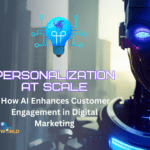
Building Your Digital Presence with Website Development and AI
In today’s digital age, the significance of websites cannot be overstated. If anyone wants to ensure their digital presence, websites act as virtual storefronts, enabling businesses, organizations, and individuals to reach a global audience and showcase their products, services, or ideas. Understanding website development with AI is the key to building an engaging and user-friendly website that captivates visitors and achieves its goals effectively.
Table of Content
- Building Your Digital Presence with Website Development and AI
- Why Websites Are Essential
- Importance of Website Development With AI in 2024
- Understanding Website Development
- Choosing the Right Platform
- Planning Your Website
- Web Design and Layout
- Front-End Development
- Back-End Development
- Content Management Systems (CMS)
- E-commerce Websites
- Search Engine Optimization (SEO)
- Testing and Quality Assurance
- Launching Your Website
- Website Maintenance and Updates
- Mobile App Development vs. Responsive Websites
- Future Trends in Website Development
- Conclusion
- FAQs
Why Websites Are Essential
Websites play a pivotal role in the online landscape. With over 1.58 billion websites and 5 billion daily users on the internet, having a well-designed and functional website is crucial for establishing your digital presence and staying competitive in your industry. Websites serve as a hub for your online activities, enabling you to connect with your target audience, promote your brand, and facilitate various transactions.
For reference Read here
Importance of Website Development With AI in 2024
Website development is the process of creating, designing, and building websites from scratch or updating existing ones. It involves a comprehensive set of tasks, including planning, design, coding, and testing, to ensure the website is visually appealing, user-friendly, and performs optimally. Effective website development ensures that your website is responsive, accessible, and optimized for search engines, contributing to an exceptional user experience.
Understanding Website Development
What is Website Development?

Website development encompasses a range of activities involved in creating a website, including frontend and backend development, content management, and user experience design. It involves both the technical aspects, such as coding and server-side operations, and the creative elements, such as visual design and user interaction.
Key Components of Website Development with AI
Key components of website development with AI include:
- Frontend Development: Frontend development deals with the visible elements of a website that users interact with directly. It involves using HTML, CSS, and JavaScript to create a responsive and user-friendly interface.
- Backend Development: Backend development focuses on server-side operations, handling data processing, database integration, and application logic to ensure the website functions smoothly.
- Content Management Systems (CMS): CMS platforms simplify website management by allowing users to update and modify content without extensive technical knowledge.
- User Experience (UX) Design: UX design ensures that the website is user-friendly, intuitive, and engaging, enhancing the overall experience for visitors.
Importance of a User-Centric Approach
A user-centric approach is vital in website development. Understanding your target audience’s needs, preferences, and pain points helps create a website that resonates with them. By prioritizing user experience, you can improve visitor engagement, reduce bounce rates, and increase conversions.
Choosing the Right Platform
Popular Website Development Platforms
When embarking on website development, choosing the right platform is crucial. Popular website development platforms include WordPress, Wix, Shopify, and Squarespace. Each platform offers unique features and functionalities suitable for different types of websites.
Factors to Consider When Choosing a Platform
When selecting a platform, consider factors such as ease of use, scalability, customization options, and cost. Additionally, assess the platform’s SEO capabilities, as this significantly impacts your website’s visibility in search engine results.
Planning Your Website

Defining Your Website’s Purpose and Goals
Before diving into the technical aspects of website development, define the purpose and goals of your website. Clearly outline what you want to achieve with your website, whether it’s to generate leads, sell products, or provide valuable information.
Creating a Sitemap and Wireframes
A sitemap is a visual representation of your website’s structure, outlining its various pages and their hierarchical relationships. Wireframes are mockups that depict the layout and design of individual pages. Creating both a sitemap and wireframes ensures a clear and organized website structure.
Understanding User Experience (UX) Design
User experience design is central to website development. Pay attention to factors like navigation, readability, and visual aesthetics to create a positive and seamless user experience. Understand your users’ journey on the website and make it as smooth and intuitive as possible.
Web Design and Layout
Importance of Responsive Design
Responsive design is a crucial aspect of modern website development. With the increasing number of mobile users, ensuring that your website adapts to different screen sizes and devices is essential. A responsive design provides a consistent and enjoyable user experience across desktops, tablets, and smartphones.
Elements of an Engaging Website Layout
An engaging website layout combines visually appealing elements with intuitive navigation. Use high-quality images, graphics, and videos to capture visitors’ attention and effectively convey your message. Clear calls-to-action guide visitors to take desired actions, such as making a purchase or contacting you.
Best Practices for Visual Design
Effective visual design goes beyond aesthetics. Consider factors like color psychology, font selection, and whitespace to create a harmonious and user-friendly design. Consistency in visual elements, such as branding and typography, reinforces your brand identity.
https://obizworld.com/ai-in-digital-marketing-complete-guide
Front-End Development
HTML, CSS, and JavaScript Basics
Frontend development relies on HTML, CSS, and JavaScript to create interactive and dynamic user interfaces. HTML provides the structure, CSS handles the presentation and layout, and JavaScript adds interactivity and functionality.
Implementing Interactive Elements
Interactive elements, such as drop-down menus, sliders, and contact forms, enhance user engagement. Implement these elements thoughtfully to create a seamless and enjoyable browsing experience.
Optimizing for Speed and Performance
Page loading speed is critical for user satisfaction and search engine rankings. Optimize images, use browser caching, and minimize HTTP requests to improve website performance.
Back-End Development
Server-Side Programming Languages
Back-end development involves using server-side programming languages like PHP, Python, or Ruby to handle data processing and application logic. Select a language that aligns with your project’s requirements and your team’s expertise.
Database Integration
Integration with a database enables your website to store and retrieve data efficiently. Choose a suitable database management system (DBMS) based on your data storage needs.
Security Considerations
Cybersecurity is a paramount concern in website development. Implement security measures, such as encryption and secure socket layers (SSL), to protect user data and prevent potential breaches.
Content Management Systems (CMS)
Advantages of Using a CMS
A CMS streamlines website management by providing a user-friendly interface for content updates. It eliminates the need for extensive coding knowledge, allowing non-technical users to maintain and modify website content.
Popular CMS Options
Popular CMS options include WordPress, Joomla, and Drupal. Each platform offers various features and plugin options, catering to different types of websites and businesses.
E-commerce Websites
Building an Online Store
For businesses seeking to sell products online, developing an e-commerce website is essential. Implement user-friendly product catalogs, secure payment gateways, and a seamless checkout process to enhance the shopping experience.
Payment Gateways and Security
Security is paramount in e-commerce development. Choose reputable payment gateways that prioritize secure transactions and implement additional security measures, such as SSL certificates and two-factor authentication.
Search Engine Optimization (SEO)
Importance of SEO in Website Development
SEO is vital for increasing organic traffic to your website. Optimize your website for search engines by incorporating relevant keywords, meta tags, and quality content.
On-Page and Off-Page SEO Techniques
On-page SEO involves optimizing individual pages on your website, while off-page SEO focuses on building backlinks and establishing your website’s authority.
Optimizing for Local SEO
For businesses with a local presence, optimizing for local SEO helps attract nearby customers and enhances visibility in local search results.
Testing and Quality Assurance
The Role of Testing in Website Development
Thorough testing is crucial before launching your website. Conduct functionality, usability, and performance testing to ensure your website works flawlessly.
Common Testing Methods
Testing methods like A/B and user testing provide valuable insights into user behavior and preferences.
Ensuring Cross-Browser Compatibility
Ensure that your website functions correctly across various web browsers and devices to reach a broader audience.
Launching Your Website
Pre-Launch Checklist
Before going live, review your website using a pre-launch checklist to address any last-minute issues.
Going Live and Monitoring Performance
Launch your website and monitor its performance using analytics tools. Regularly track website metrics and make data-driven decisions to improve user experience and achieve your goals.
Website Maintenance and Updates
Regular Maintenance Tasks
Website maintenance involves routine tasks, such as updating content, monitoring security, and fixing bugs.
Implementing Updates and Upgrades
Stay current with the latest trends and technologies by regularly implementing updates and upgrades to your website.
Mobile App Development vs. Responsive Websites
Understanding the Differences
Choose between mobile app development and responsive websites based on your business needs and target audience. Mobile apps offer enhanced user experiences for loyal customers, while responsive websites cater to a broader audience.
Pros and Cons of Each Approach
Weigh the pros and cons of mobile apps and responsive websites to make an informed decision.
Future Trends in Website Development
Emerging Technologies to Watch
Keep an eye on emerging technologies, such as Progressive Web Apps (PWAs), AI Chatbots, and voice search, to stay ahead in the ever-evolving web development landscape.
Predictions for the Future of Websites
Experts predict continued advancements in web development, focusing on optimizing user experiences on mobile and future devices, which will continue to attract and delight users consistently.
If you want to know about “Personalization at Scale: How AI Enhances Customer Engagement in Digital Marketing” Read it
Conclusion
Website development with AI is an exciting field that empowers individuals and businesses to establish a strong online presence. By understanding the key components of website development with AI, choosing the right platform, and prioritizing the user experience, you can create a website that engages visitors and achieves your goals effectively.
FAQs
- Do I need to learn coding to develop a website?
- While coding knowledge can be beneficial, using a CMS like WordPress allows you to create a website without extensive coding skills.
- What is the cost of website development with AI?
- The cost varies depending on factors like complexity, features, and the expertise of the developers. DIY options are cost-effective, but professional development ensures optimal results.
- Can I update my website after it’s live?
- Yes, CMS platforms make it easy to update content and make changes even after your website is live.
- How long does it take to develop a website with AI?
- The timeline depends on the project’s scope and complexity. Simple websites may take a few minutes, while more complex ones can take several hours.
- Is mobile app development necessary for my business?
- It depends on your business needs and target audience. Responsive websites cater to a broader audience, while mobile apps offer enhanced user experiences for loyal customers.






You can bet on these boxes and get a payout chance around 2 to 1.
Are you consistent with your bets or are you following bets when someone keep raising theirs?
Its like you read my mind You appear to know so much about this like you wrote the book in it or something I think that you can do with a few pics to drive the message home a little bit but instead of that this is excellent blog A fantastic read Ill certainly be back
Its like you read my mind You appear to know a lot about this like you wrote the book in it or something I think that you could do with some pics to drive the message home a little bit but instead of that this is fantastic blog An excellent read I will certainly be back